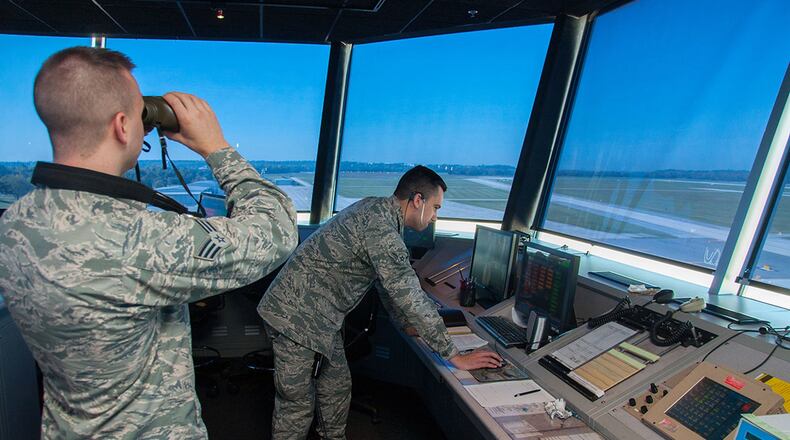“Compared to other bases, it’s not super busy, but what we do get is very complex,” said Capt. Chelsea Silsby, 88 OSS Airfield Operations Flight commander.
Complex like during recent hurricane evacuation operations when more than 65 Air Force and Navy aircraft from South Carolina and Florida found safe haven at Wright-Patt during Hurricane Irma.
Some aircraft were small fighters, like F-15 Eagles from Jackonsville, while others were bigger patrol aircraft, like the P-3 Orions and P-8 Poseidons from a Navy base in Jacksonville, with C-17s from Charleston Air Force Base finishing the mix.
How fast a plane flies, how long it takes it to go through the standard aerial path to the runway – known as the “pattern,” and how long it takes a plane to get off the runway after it’s landed all play into how complicated an air traffic controller’s job will be.
“If you have some really fast airplanes and then some slow, big ones in the same pattern, it’s a lot harder to keep them spaced apart, so that takes a lot of training for our [controllers] upstairs,” said Silsby. “Fortunately, we have a really good simulator. I would say we have the best in the Air Force, honestly. Jack Wilson is our Air Traffic Control Tower Simulator administrator, and the Air Force pulls him as a subject matter expert all the time, nationwide, to look at other people’s sims and programs, just to make sure they’re right because ours is so good.”
Wilson, a retired senior master sergeant with 21 years of active-duty air traffic controller experience, sees his mission a little simpler.
“I guarantee I create stress,” Wilson said. “I use the air traffic control simulator to create the situation to force the decision making for the air traffic controller to learn. I want to prepare them as if I was the watch supervisor [in the tower].”
In the case of the recent hurricane evacuation, Wilson had already put his controllers through a HUREVAC scenario at the start of hurricane season as he does every year. Silsby said that because the controllers had already been put through the paces of controlling high numbers of different kinds of aircraft landing at Wright-Patt in quick succession on the simulator, it made the actual HUREVAC more of an exciting event for her controllers instead of a stressful one.
“Mr. Wilson has dedicated a lot of time and effort, above and beyond what is even expected of him, to develop scenarios,” said 88 OSS Chief Controller Master Sgt. Bethany Norton. “He could essentially just create a sim and let people run with it. But, he creates different sims for each trainee every time they go down to see him on a daily basis.”
Wilson trains air traffic controllers from apprentice level through journeyman at Wright-Patt as one of nearly 90 Air Force bases that train apprentice controllers straight from their initial technical training. The training takes about a year and isn’t easy – about 70 percent wash out from the program, according to Wilson.
“With the lack of traffic that we have here on a day-to-day basis, we couldn’t have competent controllers without him,” said Senior Airman Tyler Jacobs, 88 OSS air traffic controller journeyman. “Because to get rated in position, you’re supposed to have up to four aircraft at the same time in the air and the amount of times we actually see that here with live traffic is very few and far between. So, to be able to train on that every day [on the simulator] is crucial.”
It’s not only airplanes depicted on the simulator either. The Airfield Operations Flight is divided into two parts: air traffic control and airfield management. Together, they are responsible for controlling all air traffic around a 5-mile radius of the base as well as everything on the flight line, including all vehicle traffic, maintenance, construction and personnel.
“In air traffic, they have to know how to do air traffic control for every type of aircraft in the inventory,” Silsby said. “Then for airfield management, they have to know the rules for parking and wingtip clearance for every aircraft in the inventory. They know the rules on what the airfield needs to look like at the end of the day and so they work with all these different teams across the base to make sure that that happens.”
That could mean working with base civil engineers to get construction completed on the airfield while minimizing its impact on flight operations or ensuring that pilots and air crews get the logistical support they need after landing, according to Silsby. During the HUREVAC, it additionally meant figuring out where to put all the planes, a feat Silsby gave great credit to Airfield Manager Rome Alcantara for accomplishing with his team.
“It looks like we have a lot of pavement but it’s still like a big [puzzle] to try to get everything to fit in an appropriate and safe place,” Silsby said.
Wilson says that while Wright-Patterson may be rated the 84th busiest control tower in the Air Force, the mission is just as important here as it is anywhere.
“I know I have to equip them with the tools to be successful,” Wilson said. “Because if I’m the manager down range, I don’t want a weak link. I want somebody that’s exposed to the rules and practiced the rules. I want them to be confident because deployments are stressful as it is. I want them to find a comfort level and find it fast, and really contribute at the tip of the spear for the mission on the other side of the world.”
About the Author
